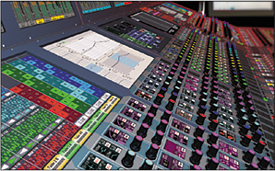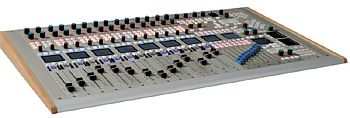Audio Consoles—The New and the Old

Are audio consoles obsolete in the age of digital audio workstations and computer audio editing programs? Not by a long shot.
Otherwise, we wouldn't be seeing the innovation in audio console design shown at the 2009 NAB Show, nor the digital audio upgrades at major facilities, nor the secondary market for older, and more often than not, analog boards.
IN WITH THE NEW
With current console design, the actual console part—the surface with the knobs, faders, switches, and meter displays—is just one component of an entire audio control and mixing system. The core of the system, which is often located outside of an audio control room in a central equipment area, includes routing switchers that can handle the diversity of audio inputs and outputs, digital signal processing cards, interfaces for intelligent machine control and GPI, redundant power supplies, and connector panels.
As for innovations this year, digital signal processing has to top the list. All the major console manufacturers have ramped up their DSP power to not only increase the range of such controls as sample rate converters, input gain, equalization, dynamics, delay and level, but to provide these capabilities to an ever-increasing amount of audio channels demanded by surround-sound productions. There are console systems that can provide this level of processing for all channels full time. In systems where DSP resources are shared, the base level of DSP power is being increased to cover most of the situations that that model will be used in.
These days you just can't seem to have too many physical audio channels. With the demand for surround sound increasing, more recording devices and other sources routinely provide six or more audio channels for each single video. Surround sound can also mean more microphone channels, not only for the main sound, but to capture the ambience as well.

The new Calrec Apollo Console system manufacturers address this by increasing the size of their audio routers, and providing a wide array of audio interfaces—analog, AES3 in 110 ohm and 75 ohm interfaces, MADI, MIDI, CAT5, to name the most common, plus the ability to handle different sample rates of digital signals.
Built-in console system audio routing can take the place of some or all of a plant audio routing system, thus simplifying the overall design. That's why we're seeing more control interfaces between the audio system and central routing systems in addition to a wider variety of digital audio workstations.
Networking capabilities for these larger routing switchers are enhanced accordingly, so that signals can be easily shared across routers and other digital router-based systems like intercoms. This capability helps simplify system design and saves on racks of distribution amplifiers, not to mention miles of cabling, especially when more than one audio control room shares common resources.
Control surfaces, too, are seeing redesigns to make it easier for the operator to see at-a-glance channel settings and status and to grab the right control at the right time. More control surfaces are taking advantage of LEDs incorporated into knobs that change color depending on function, and built-in OLED video displays for status, programming and metering information.
Consoles are becoming more flexible in how they can be configured, letting the operator have it his or her own way. Some may prefer having each channel's controls in an in-line configuration similar to analog boards, while others may prefer a central control section.
THE VALUE OF OLD
When a facility upgrades to a new digital console system, they face the question of how to dispose of the old analog or digital console. It may not need to go into the dumpster. Apart from this being an environmentally unfriendly way of handling the situation, the old console may have value to the facility getting rid of it, and a new life somewhere else.

The Logitek Artisan Console features the company's Audio Engine router Professional Audio Design Inc. is one company that buys older consoles, refurbishes them, and sells them on the secondary market.
For the facility selling, "we provide a way to maximize their investment," said Dave Malekpour, president, Professional Audio Design in Rockland, Mass. "Analog consoles and processors still have value to other types of users."
Facilities that are upgrading can trade in their old boards to help finance the purchase of the new ones. For facilities on tight budgets, adding refurbished gear that comes with a warrantee can be a great way to stretch funds.
Malekpour said some of the consoles his company resells are used in audio production rooms, recording studios that offer analog mixing, and broadcasters that need a smaller analog or digital desk to tie in with a digital audio workstation. Others are sold overseas, or to colleges or training facilities.
Then there are sound mixers who prefer the sound of true analog processors like mic preamps, equalizers and compressor/limiters to their digital counterparts, or at least like to have them in their audio tool kit.
Whether new or refurbished, physical audio consoles provide that tactile feel that sound mixers still tend to prefer, allowing them to make quick real-time adjustments to the mix, and get to the visual cues they need in order to see what's happening with all the channels under their control.
Even in a virtual universe, there are times you still need something that's real.
Mary C. Gruszka is a systems design engineer, project manager, consultant and writer based in the New York metro area. She can be reached via TV Technology.
Get the TV Tech Newsletter
The professional video industry's #1 source for news, trends and product and tech information. Sign up below.
